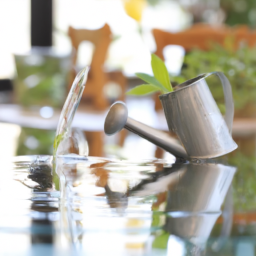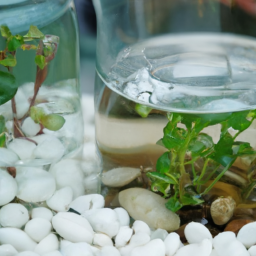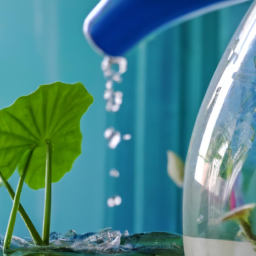
Can I grow indoor plants in water? This is a question that many plant enthusiasts and beginners often ask themselves. If you’ve ever wondered about the possibility of growing your favorite houseplants without soil, you’re in the right place. In this blog post, we will explore the fascinating world of hydroponics and discuss the feasibility of cultivating indoor plants solely in water. So, if you’re curious to learn more about this innovative gardening technique and its benefits, keep reading!
Benefits of Growing Indoor Plants in Water
Indoor plants not only add beauty and freshness to our living spaces, but they also provide numerous health benefits. One popular method of growing indoor plants is in water. This hydroponic technique offers several advantages over traditional soil-based cultivation. In this article, we will explore the benefits of growing indoor plants in water and provide you with a step-by-step guide to get started.
Improved Air Quality
Growing indoor plants in water can significantly improve the air quality in your home or office. Plants naturally absorb carbon dioxide and release oxygen through photosynthesis. This process helps to purify the air by removing harmful toxins and pollutants, such as formaldehyde, benzene, and trichloroethylene. By having a few water-grown plants in your indoor space, you can enjoy cleaner and fresher air, which can have a positive impact on your overall well-being.
Moreover, certain plants are particularly effective in removing specific toxins. For instance, the Peace Lily (Spathiphyllum) is known for its ability to filter out formaldehyde, while the Spider Plant (Chlorophytum comosum) excels at removing carbon monoxide and xylene. By choosing the right plants for your indoor water garden, you can optimize the air purification process.
Additionally, water-grown plants release moisture into the air through a process called transpiration. This natural humidification can help combat dry indoor air, especially during the winter months when heating systems tend to dry out the environment. The increased humidity not only benefits your respiratory system but also helps keep your skin and mucous membranes hydrated.
Low Maintenance and Pest-Free
One of the greatest advantages of growing indoor plants in water is the low maintenance they require. Unlike traditional potted plants that need regular watering and fertilizing, water-grown plants can thrive with minimal effort. Once you set up the hydroponic system, you can enjoy the beauty of your plants without worrying about soil moisture or root rot.
Furthermore, water-grown plants are less susceptible to pests and diseases. Soil-borne pests, such as fungus gnats and root aphids, are eliminated when you remove the soil from the equation. This means you can say goodbye to the hassle of dealing with pests and the need for harmful pesticides. With proper care and monitoring, your water-grown plants can remain healthy and pest-free for a long time.
It is important to note that while water-grown plants require less maintenance, they still need some attention. Regularly check the water quality and ensure it is free from contaminants. Maintain the appropriate water level and change it periodically to prevent stagnation. Additionally, monitor the roots for any signs of decay or nutrient deficiencies.
Enhanced Growth and Aesthetic Appeal
Indoor plants grown in water often exhibit enhanced growth compared to their soil-based counterparts. This is because the roots receive direct access to oxygen, nutrients, and water, leading to faster and healthier growth. The absence of soil also eliminates the risk of overwatering or underwatering, as the roots can absorb moisture as needed.
Another advantage of water-grown plants is their aesthetic appeal. The transparent containers used for hydroponics allow you to observe the intricate root systems, which can be quite fascinating. You can choose from a variety of containers, such as glass jars, vases, or specialized hydroponic systems, to create visually appealing displays. The combination of lush green foliage and the graceful underwater root structures can truly elevate the ambiance of any indoor space.
Moreover, growing indoor plants in water provides you with the opportunity to experiment with different plant species and arrangements. You can create beautiful terrarium-like setups or vertical gardens using trailing or climbing plants. The versatility of water-based cultivation allows you to unleash your creativity and design unique indoor landscapes.
Now that you are aware of the benefits of growing indoor plants in water, you can embark on your hydroponic journey. Remember to choose suitable plants, maintain water quality, and enjoy the beauty and advantages of this innovative gardening technique. Happy growing!

Best Indoor Plants to Grow in Water
Indoor plants not only enhance the aesthetic appeal of your living space but also provide numerous health benefits. Growing indoor plants in water is a popular and convenient way to bring nature indoors. It eliminates the need for soil and can be an interesting alternative for people with limited space or those who prefer low-maintenance plants. In this article, we will explore some of the best indoor plants that thrive when grown in water.
1. Pothos
Pothos, also known as Devil’s Ivy, is a popular choice for water propagation. It is a hardy plant that can adapt to different light conditions, making it ideal for indoor spaces. To grow pothos in water, simply take a cutting with at least two nodes and place it in a jar filled with water. Change the water every one to two weeks to prevent stagnation and promote healthy growth. Pothos can grow roots in water within a few weeks and will continue to thrive as long as it receives adequate light and nutrients.
One of the advantages of growing pothos in water is that you can easily monitor the root development. The roots will display a beautiful, cascading pattern as they grow. Pothos plants are also known for their air-purifying qualities, making them an excellent choice for improving indoor air quality.
When it comes to displaying your pothos in water, you can get creative with various containers such as glass jars, vases, or even repurposed bottles. The cascading vines of pothos can create an eye-catching display, whether placed on a shelf, hanging from a macrame hanger, or trained to climb a trellis.
2. Spider Plant
The spider plant, scientifically known as Chlorophytum comosum, is another popular indoor plant that can be easily grown in water. Its long, arching leaves with white stripes add a touch of elegance to any space. Spider plants are known for their resilience and ability to adapt to different environments, making them a great choice for beginners.
To propagate a spider plant in water, select a healthy plantlet or offset with a few roots and place it in a container filled with water. Ensure that the roots are submerged but keep the leaves above the water level. Spider plants prefer bright, indirect light, so place them near a window where they can receive filtered sunlight.
Spider plants are known for their ability to produce plantlets or “spiderettes” that dangle from the mother plant. These plantlets can be easily propagated in water, allowing you to expand your spider plant collection. With proper care, spider plants can grow lush and produce beautiful white flowers.
3. Chinese Evergreen
The Chinese Evergreen, also known as Aglaonema, is a popular choice for indoor gardening due to its attractive foliage and low maintenance requirements. It can tolerate low light conditions, making it suitable for areas with limited natural light. Chinese Evergreen plants are known for their air-purifying abilities, removing toxins from the air.
To grow a Chinese Evergreen in water, select a healthy stem cutting with at least two nodes and place it in a container filled with water. Ensure that the nodes are submerged, as this is where the roots will develop. Change the water every two weeks to prevent the buildup of bacteria and algae.
Chinese Evergreen plants can thrive in water for an extended period, but it’s essential to provide them with adequate light. Place them near a window with indirect sunlight or use artificial grow lights to ensure their growth and vibrant foliage.
Indoor plants grown in water can bring life and freshness to any space. Whether you choose pothos, spider plants, Chinese Evergreen, or any other water-loving plant, remember to regularly change the water, provide adequate light, and enjoy the beauty and benefits of these easy-to-grow indoor plants.

How to Care for Indoor Plants Grown in Water
Indoor plants can bring life and beauty into any space, and growing them in water can be a fascinating and rewarding experience. Not only does it eliminate the need for soil, but it also adds a unique touch to your indoor gardening. In this article, we will guide you through the step-by-step process of caring for indoor plants grown in water, ensuring they thrive and flourish.
Choosing the Right Plants
The first step in growing indoor plants in water is to choose the right plants that are suitable for this method. While not all plants can survive solely in water, there are several popular varieties that thrive in this environment. Pothos, philodendron, spider plants, and lucky bamboo are some of the most common choices for water-based indoor gardening.
When selecting plants, consider their adaptability to water, light requirements, and size. Make sure to choose plants that have healthy root systems, as they will be the primary source of nutrients for the plant. Once you have chosen your plants, it’s time to move on to the next step.
Preparing the Water and Container
Before transferring your plants to water, it is important to prepare the right type of water and container. When it comes to water, it is best to use filtered or distilled water to avoid any potential contaminants that could harm your plants. Tap water may contain chemicals like chlorine or fluoride that can be detrimental to their growth.
As for the container, you can choose any transparent glass or plastic vessel that allows light to pass through. Mason jars, glass bottles, or vases are popular choices. Ensure that the container is clean and free from any residue or chemicals that could harm the plants.
Fill the container with water, leaving enough space for the roots to grow. It is recommended to use room temperature water as extreme temperatures can shock the plants. Once the water and container are ready, you can proceed with transferring your plants.
Transferring the Plants
Transferring your plants to water is a delicate process that requires care and attention. Start by gently removing the plant from its current pot, being careful not to damage the roots. Gently rinse the roots under running water to remove any soil or debris.
Place the plant in the prepared container, ensuring that the roots are fully submerged in water. You may need to use rocks or marbles to stabilize the plant and prevent it from toppling over. Avoid submerging any leaves or stems in water, as this can lead to rotting.
Position the container in a location that receives bright, indirect light. Avoid placing it in direct sunlight as it can cause excessive heat and damage the plant. It is important to note that different plants have varying light requirements, so make sure to research the specific needs of your chosen plants.
Providing Adequate Care
Now that your indoor plants are comfortably settled in water, it’s time to provide them with the care they need to thrive. Here are some essential tips:
1. Water Quality: Monitor the water quality regularly and change it every two to three weeks to prevent the buildup of algae or bacteria. Remember to use filtered or distilled water to maintain optimal conditions for your plants.
2. Nutrient Supply: While some plants can survive solely on water, others may require additional nutrients to thrive. You can add a small amount of liquid fertilizer specifically formulated for hydroponic plants. Follow the instructions on the fertilizer package for the correct dosage.
3. Root Maintenance: Check the roots regularly for any signs of rot or decay. If you notice any unhealthy roots, trim them off using clean scissors or pruning shears. This will promote healthy growth and prevent the spread of diseases.
4. Light Exposure: Ensure that your plants receive adequate light, but avoid direct sunlight. Rotate the container every few days to ensure even light distribution and prevent the plants from leaning towards one side.
5. Temperature and Humidity: Most indoor plants prefer temperatures between 60-75°F (15-24°C) and moderate humidity levels. Avoid exposing them to extreme temperature fluctuations or dry air, as it can stress the plants.
6. Pest Control: Keep an eye out for common indoor plant pests like aphids, mealybugs, or spider mites. If you notice any signs of infestation, treat the plants with an appropriate insecticide or try natural remedies like neem oil or insecticidal soap.
By following these care guidelines, your indoor plants grown in water will thrive and bring beauty to your space. Enjoy the unique experience of tending to these fascinating plants and watch them flourish in their aquatic environment!
In Summary
Indoor plants have become increasingly popular in homes and offices, adding a touch of greenery and freshness to any space. But what if you don’t have a green thumb or simply don’t want the hassle of dealing with soil? Can you still grow indoor plants without it? The answer is yes – you can grow indoor plants in water!
Growing indoor plants in water, also known as hydroponics, is a fantastic alternative to traditional soil-based gardening. Not only does it eliminate the mess and maintenance associated with soil, but it also allows for better control over the plant’s nutrient intake. To get started, all you need is a container, water, and a few plant cuttings or seeds. Simply place the cuttings or seeds in the water, making sure the roots are submerged, and watch as your plants thrive and grow. Just be sure to change the water regularly to prevent stagnation and the growth of harmful bacteria. Overall, growing indoor plants in water is a convenient and low-maintenance way to bring nature indoors and enjoy the benefits of greenery without the fuss of soil.
Here are this week’s Top Questions and Answers
Q1: Can I grow indoor plants in water?
A1: Yes, you can definitely grow indoor plants in water! It’s called hydroponics, a method of growing plants without soil. Many houseplants can thrive and grow beautifully in water, making it a popular choice among indoor gardeners.
Q2: How does growing plants in water work?
A2: Growing plants in water involves providing the necessary nutrients and support for the plants to grow without soil. You can start by placing the plant cutting or root in a container filled with water, making sure the water level covers the roots. The plant will absorb essential nutrients through its roots, allowing it to grow and flourish.
Q3: What plants can be grown in water?
A3: Several indoor plants can be grown in water successfully. Some popular choices include pothos, philodendron, spider plants, lucky bamboo, and Chinese evergreen. These plants are known for their ability to adapt and thrive in water, making them ideal for indoor hydroponics.
Q4: What do indoor plants in water need to thrive?
A4: Indoor plants grown in water require a few essentials to thrive. Firstly, they need a clean container with enough water to cover their roots. It’s important to change the water every two weeks or so to prevent the growth of algae and maintain oxygen levels. Additionally, you can add liquid plant fertilizer to provide the necessary nutrients for healthy growth.
Q5: Are there any disadvantages to growing indoor plants in water?
A5: While growing indoor plants in water offers numerous benefits, there are a few potential drawbacks to consider. Since plants in water lack the support of soil, they may require additional staking or support to prevent them from toppling over. Additionally, some plants may have a harder time transitioning back to soil if you decide to switch their growing medium. Lastly, maintaining water quality and preventing the growth of algae can be a bit more challenging compared to traditional soil-based gardening.

James Wong is a renowned ethnobotanist, plant scientist, and local television presenter. With a passion for demystifying plant science, he is known for translating complex botanical concepts into practical advice for everyday plant enthusiasts. James’s expertise spans from traditional gardening to cutting-edge plant technologies, making his insights accessible and informative.


